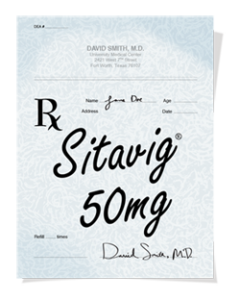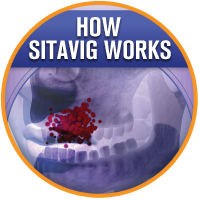Dosing & Administration
Applying Sitavig
- SITAVIG 50mg buccal tablet should be applied as a single dose to the upper gum (canine fossa) region.
- SITAVIG should be applied within one hour after the onset of prodromal symptoms and before the appearance of any signs of herpes labialis.
- Instruct patients not to crush, chew, suck or swallow tablets.
Dosage Forms and Strengths
50mg buccal tablets.
Contraindications1
Known hypersensitivity to acyclovir, milk protein concentrate, or any other component of the product.
Adverse Reactions
Most common adverse reactions (≥1%) are: headache and application site pain. For more information, please view Sitavig Full Prescribing Information (PDF — Adobe Acrobat Reader Required).
Additional resources:
For more information:
- Sitavig [package insert]. Charleston, SC: EPI Health LLC; 2015.
Indication & Important Safety Information
INDICATION
Sitavig® (acyclovir) 50 mg buccal tablet is indicated for
the treatment of recurrent herpes labialis (cold sores) in immunocompetent
adults.
IMPORTANT SAFETY INFORMATION
- Sitavig® (acyclovir) 50 mg buccal tablet should not be used in patients with known hypersensitivity to acyclovir, milk protein concentrate, or any other component of the product.
- Sitavig has not been studied in immunocompromised patients. No interaction studies have been performed. Sitavig’s safety and efficacy have not been established in pediatric patients.
- There are no available data on Sitavig use in pregnant women. However, published observational studies over decades of use of acyclovir have not identified a drug-associated risk of major birth defects, miscarriage, or adverse maternal or fetal outcomes. It is not known if Sitavig is excreted in breast milk; however, systemic exposure following buccal administration of acyclovir is minimal. Before administration, discuss if the patient is lactating or planning to breastfeed.
- The possibility of viral resistance to acyclovir should be considered in patients who fail to respond or experience recurrent viral shedding during therapy.
- In a controlled clinical trial, the most common side effects (greater than or equal to 1%) for Sitavig were: headache (3%), dizziness (1%), lethargy (1%), gingival (gum) pain (1%), aphthous stomatitis (canker
sores) (1%), application site pain (1%), application site irritation (1%), erythema (redness) (1%), and rash (1%). In the same trial, these side effects ranged from 0% to 3% for placebo.
You are encouraged to report negative side effects of prescription
drugs to the FDA. Call
1-800-FDA-1088 or visit www.fda.gov/medwatch.
Please see Full Prescribing Information.


